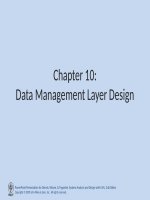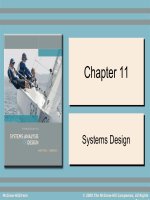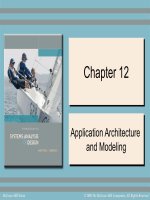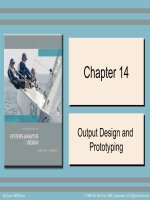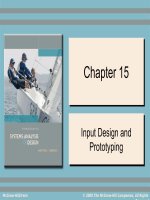Lecture Introduction to systems analysis and design Chapter 11 Whitten, Bentley
Bạn đang xem bản rút gọn của tài liệu. Xem và tải ngay bản đầy đủ của tài liệu tại đây (810.65 KB, 33 trang )
Chapter
Chapter 11
11
Systems
Systems Design
Design
McGraw-Hill/Irwin
© 2008 The McGraw-Hill Companies, All Rights
Objectives
• Describe the design phase in terms of your
information building blocks.
• Identify and differentiate between several
systems design strategies.
• Describe the design phase tasks in terms of a
computer-based solution for an in-house
development project.
• Describe the design phase in terms of a
computer-based solution involving procurement
of a commercial systems software solution.
11-2
Systems Design
Systems design – the specification of a detailed
computer-based solution.
– Also called physical design.
– Systems analysis emphasizes the business problem
– Systems design emphasizes the technical or
implementation concerns of the system.
11-3
Systems Design Approaches
• Model-Driven
–
–
–
–
Modern structured design
Information engineering
Prototyping
Object-oriented
• RAD
• JAD
11-4
Model-Driven Approaches
Model-driven strategy – a system design
approach that emphasizes drawing system
models to document technical and
implementation aspects of a system.
11-5
Model-Driven Approaches –
Modern Structured Design
Modern structured design – a system design
technique that decomposes the system’s
processes into manageable components.
– Synonyms (although technically inaccurate) are
top-down program design and structured
programming.
– Design in a top-down hierarchy of modules.
– Easier to implement and maintain (change).
– Modules should be highly cohesive
• Accomplish one function only
– Modules should be loosely coupled
11-6
• Minimally dependent on one another
Structure Chart
11-7
Model-Driven Approaches –
Information Engineering
Information engineering (IE) – a model-driven
and data-centered, but process-sensitive
technique for planning, analyzing, and designing
information systems. IE models are pictures that
illustrate and synchronize the system’s data and
processes.
– The primary tool of IE is a data model diagram.
11-8
Physical Entity Relationship
Diagram
11-9
Model-Driven Approaches –
Prototyping
Prototype – a small-scale, incomplete, but working
sample of a desired system
Iterative process involving a close working relationship
between the designer and the users.
Key Benefits:
11-10
– Encourages and requires active end-user participation.
– Iteration accommodates end-users who tend to change their
minds.
– Endorses philosophy that end-users won’t know what they
want until they see it.
– Active model that end-users can interact with.
– Errors can be detected earlier.
– Can increase creativity as it allows for quicker user feedback.
– Accelerates several phases of the life cycle.
Model-Driven Approaches –
Prototyping
Disadvantages and Pitfalls:
– Encourages “code, implement, and repair” life cycle that
cause maintenance nightmares.
– Still need systems analysis phases, but so easy to skip.
– Cannot completely substitute a prototype for a paper
specification (like architect without a blueprint).
– Numerous design issues are not addressed by
prototyping.
– Often leads to premature commitment to a design.
– Scope and complexity of the system can expand out of
control.
– Can reduce creativity in designs.
– Often suffer from slower performance because of
language considerations (rapidly becoming a non-issue).
11-11
Prototype screen
11-12
Model-Driven Approaches –
Object-Oriented Design
Object-oriented design (OOD) techniques are
used to refine the object requirements definitions
identified earlier during analysis, and to define
design specific objects.
– Extension of object-oriented analysis
– Attempt to eliminate the separation of concerns
about data and process.
11-13
Object-Oriented Design Model
11-14
Rapid Application Development
(RAD)
Rapid application development (RAD) – a
systems design approach that utilizes
structured, prototyping, and JAD techniques to
quickly develop systems.
– The merger of various structured techniques to
accelerate systems development
• Data-driven information engineering
• Prototyping
• Joint application development
11-15
Joint Application Development
(JAD)
Joint Application Development (JAD) is a
technique that complements other systems
analysis and design techniques by emphasizing
participative development among system
owners, users, designers, and builders.
11-16
During the JAD sessions for systems design,
the systems designer will take on the role of
facilitator for possibly several full-day workshops
intended to address different design issues and
deliverables.
In-House Development
Projects (Build)
11-17
System Design Tasks For
In-House Development
11-18
System Design Tasks For InHouse Development (Build)
• Design the Application Architecture
– Define technologies to be used by (and used to build)
one, more, or all information systems.
– Revise models as physical models
• Design the System Databases
– Database schema
– Optimized for implementation DBMS
• Design the System Interface
– Input, output, and dialogue specifications
– Prototypes
• Package Design Specifications
– Specifications to guide programmers
• Update Project Plan
11-19
Physical Data Flow Diagram
11-20
Output Prototype Screen
11-21
Dialogue Interface Prototype
Screen
11-22
System Design For “Buy”
Solutions
11-23
Tasks for Procurement Phase
11-24
Tasks for Procurement Phase
•
•
•
•
•
11-25
Research Technical Criteria and Options
Solicit Proposals or Quotes from Vendors
Validate Vendor Claims and Performances
Evaluate and Rank Vendor Proposals
Award Contract and Debrief Vendors
